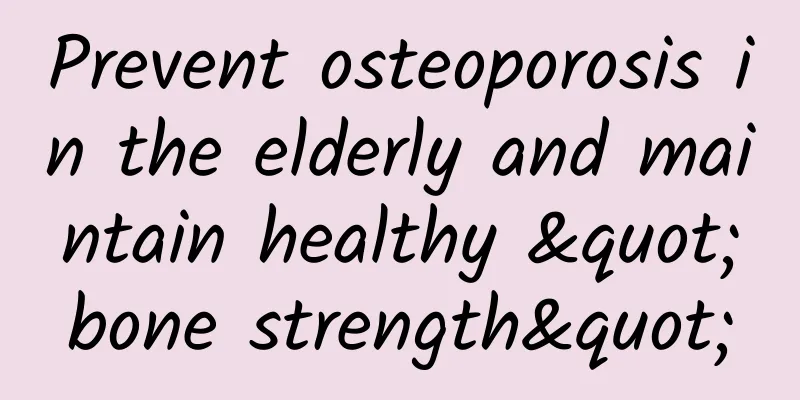Prevent osteoporosis in the elderly and maintain healthy "bone strength"

|
Author: Ding Yan Nanjing Drum Tower Hospital Reviewer: Jiang Min, Chief Physician, Nanjing Drum Tower Hospital As people age, their bones gradually become fragile, and osteoporosis has become a common health risk among the elderly. This disease not only causes obvious symptoms such as bone pain, gradual loss of height, and hunchback, but also greatly increases the risk of fractures, especially in key areas such as the hip, spine, and wrist. These fractures often have a profound impact on the daily lives of the elderly, not only seriously reducing their quality of life, but may also threaten their lives in some cases. Figure 1 Copyright image, no permission to reprint Effective prevention and treatment measures for osteoporosis cover many aspects. The first is to cultivate a healthy lifestyle. This means that you need to exercise moderately every day, which is essential for maintaining bone mass. At the same time, ensuring a balanced nutritional intake is also the key to preventing osteoporosis, including adequate nutrients such as calcium, vitamin D and protein. For elderly patients with osteoporosis, it is particularly important to prevent falls to reduce the risk of fractures. Once a fracture occurs due to osteoporosis, surgical treatment may be required. In addition, drug treatment should not be ignored. It is mainly divided into two categories: promoting bone formation and inhibiting bone resorption, both of which are effective treatment methods. Here are some effective prevention strategies: 1. Healthy Diet Ensure adequate calcium intake: Calcium is the main component of bones, so the elderly must ensure that their diet contains adequate calcium sources. Foods rich in calcium include dairy products (such as milk, yogurt), soy products (such as tofu, soy milk), green leafy vegetables (such as spinach, broccoli), small fish and shrimp, etc. Figure 2 Copyright image, no permission to reprint Vitamin D supplementation: Vitamin D is essential for promoting calcium absorption. In addition to intake through food (such as cod liver oil, egg yolk), moderate sun exposure is also an effective way to obtain vitamin D. Direct sunlight can promote the synthesis of vitamin D in the skin, which is of great benefit to the increase of bone mass and bone formation. Maintain a balanced diet: In addition to calcium and vitamin D, older adults should also maintain a balanced diet and ensure adequate protein, minerals, and vitamins to maintain the health of bones and other body organs. 2. Moderate exercise Aerobic exercise: such as brisk walking, jogging, swimming, etc. These exercises can enhance cardiopulmonary function, promote blood circulation, and help supply nutrients to bones. Weight-bearing exercise: such as weightlifting, push-ups, etc. These exercises can increase the load on bones and promote bone growth and strengthening. However, the elderly should do weight-bearing exercises within their ability to avoid injuries caused by excessive exercise. Flexibility training: Such as yoga, Tai Chi, etc. These exercises can improve the body's flexibility and balance, and help reduce the risk of falling. Figure 3 Copyright image, no permission to reprint 3. Avoid bad living habits Quit smoking and limit alcohol consumption: Long-term smoking and excessive drinking increase the risk of osteoporosis. Tobacco and alcohol affect the nutrient supply to bones and the function of bone cells. Drink less strong tea and coffee: Certain ingredients in strong tea and coffee can inhibit the gastrointestinal absorption of calcium, so the elderly should drink them in moderation. IV. Regular examination and drug treatment Regular check-ups: The elderly should undergo regular bone density checks to detect signs of osteoporosis in a timely manner and take appropriate preventive and therapeutic measures. Drug treatment: For elderly people who have been diagnosed with osteoporosis, they should use drugs for intervention treatment under the guidance of professional doctors. Commonly used drugs include calcium tablets, vitamin D, bisphosphonates and other types. However, it is important to remember that drug treatment is only a part of the overall treatment plan, and it needs to be combined with other health care measures to work together. |
<<: The "hidden" escapee: cervical adenocarcinoma
>>: Fruits are getting sweeter. Is it a "sweet gift" or a "sweet crisis"? | Ronggeluoke
Recommend
Protect your kidneys: Three golden habits to stay away from kidney failure
1. Regular work and rest, adequate sleep: Ensurin...
How to maintain ovaries and uterus
Every woman hopes that she can stay young and bea...
Symptoms of acute mastitis suppuration, a must-read for women!
Acute mastitis is an acute suppurative disease of...
If these small bags appear on your skin, they may not be acne, so don’t squeeze them!
I believe that many people have seen this kind of...
Infographic: Politics in a digital world
Social media and connected smartphones have change...
Hysterosalpingography cannulation pictures
Contrast examination requires the introduction of...
Follow the doctor to Tibet | Set off again! Zhengzhou Seventh Hospital went to Tibet for the fifth time to screen and rescue children with congenital heart disease
Dahe.com News: On the morning of July 8, the &quo...
Early orthodontic treatment for children protects their oral health - the key to good teeth is early orthodontic treatment for children
Author: Ahesha Wulie, School of Stomatology, Huaz...
How were the Egyptian pyramids built? Which continent does Egypt belong to?
Egypt is a country in northeastern Africa. It is ...
Sudden severe pain in the lower abdomen of women
In daily life, many women have experienced sudden...
Will I still have vaginal discharge when I am pregnant?
Will there be leucorrhea during pregnancy? Many p...
What should I do if a pregnant woman has anemia?
Pregnant women will encounter a lot of discomfort...
What lipstick is suitable for cold white skin? Will my lips become darker if I apply lipstick every day?
As we all know, lipstick is a lip cosmetic. Its m...
How to preserve live sea cucumbers? How long after eating sea cucumbers can you eat fruit?
The acidic environment will change the spatial st...









